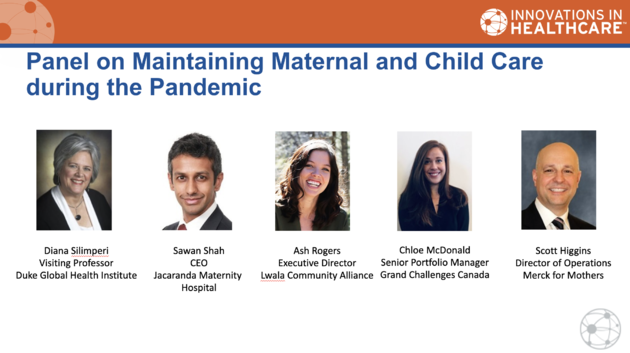May 13, 2020 LAN Biweekly Call Summary
Click here to view the recording.
The webinar first featured a panel, Maintaining Maternal and Child Care During the Pandemic.
Panelists included:
-
Diana Silimperi, visiting professor at Duke Global Health Institute
-
Sawan Shah, CEO of Jacaranda Maternity Hospital
-
Ash Rodgers, Executive Director of Lwala Community Alliance
-
Chole McDonald, Senior Portfolio Manager for Grand Challenges Canada, and
-
Scott Higgins, Director of Operations at Merck for Mothers
Dr. Silimperi started off the panel by giving an overview of concerning impacts on maternal and child health as a result of COVID-19 caused disruptions in routine healthcare. As resources such as personnel and pharmaceuticals are shifted to hotspots where COVID-19 is most prevalent, researchers predict that more lives will be lost due to health delivery systems and supply chain reductions than the virus itself. Johns Hopkins University recently published a report in the Lancet modeling 3 different scenarios, in which one scenario predicted that a 45% reduction would result in 1,157,000 child deaths and nearly 57,000 maternal deaths.1 WorldVision and the International Rescue Committee predicted that in 24 fragile states, nearly 26 million people are at risk for ‘secondary health impacts’. These include higher fatality rates from preventable infectious diseases, malaria, and malnutrition as a result of decreased routine care.
Jacaranda Maternity is a social enterprise that largely focuses on low-income settings in Kenya and East Africa. Shah speaks to the company’s financial, operational, clinical, and strategic responses, primarily focusing on operations in order to protect healthcare workers and prevent the spread of the disease. Just a few changes the health system has made include: reorganizing staff workflows in order to create room for social distancing, scheduling appointments to stagger patient arrival, requiring that all personnel wear masks and undergo temperature screening, and social media/signage to ensure patients understand why such changes have occurred. Clinical responses involve an ongoing process to utilize published WHO and Japanese best practices, financial responses flexibly adjusted to higher operating costs and fewer insurance company payments, while strategic responses questioned how Jacaranda could seek new opportunities to emerge stronger after the pandemic. In particular, Jacaranda is piloting various telehealth, pharmaceutical delivery, and transportation programs.
The Lwala Community Alliance is a community health organization in Kenya focused on four pillars: community committees, community health workers, health centers, and data. In response to the pandemic, its priorities have been to: protect health workers, interrupt the spread of the virus, maintain essential services while surging the health system’s capacity, and shield the most vulnerable from socioeconomic shocks. Rodgers details Lwala’s action towards maintaining essential services, which includes providing PPE for all healthcare providers including Community Health Workers (CHWs), revising CHW protocol, and employing digital tools to help CHWs perform COVID-19 self and phone screening. At the village level (while practicing social distancing), Lwala has implemented well-patient outreaches that offer primary care services so as to prevent overflow at health centers. Lastly, they have implemented mass radio and bulk SMS programs regarding COVID-19 and WASH messaging. Rodgers highlights that much of Lwala’s work is done with the Community Health Impact Coalition, which assisted in publishing three papers on health implementation in the time of COVID-19.
As a funding organization part of Global Affairs Canada, Grand Challenges Canada is continuing maternal and child health innovation funding while building public, demand-side strategic partnerships for uptake of such innovations. To do so, it has formulated a two-fold approach. The first element is adjusting existing grant agreements and loans to suit recipients’ COVID-19 needs, while the second is to employ additional funding in existing portfolios. Grand Challenges Canada first focused on PPE, oxygen access, and digital health tools to promote patient care and combat misinformation. It then centered around ensuring continued access to essential services, such as COVID-19 related training for CHWs. Through this strategy, it hopes to most effectively and efficiently address maternal and child health needs in the face of the pandemic.
The final panelist, Scott Higgins, spoke about the key takeaways Merck for Mothers has gleaned from its diverse partners over the course of the pandemic. To begin, many local stakeholders are focused on filling the information void--creating learning platforms to educate personnel on infection control and the care and treatment of patients. Second, partners emphasized the need for innovation and flexibility in how care is delivered and information is shared in the context of access to technology and doing so equitably. Lastly, all actors are contemplating ways to effectively manage resources, using solutions such as public-private partnerships to accelerate care.
There were two questions panelists addressed: (48:35)
-
Are there any particular innovations you would like to highlight?
-
How are you dealing with “demand reduction,” in which patients and users are “afraid” of going to the health posts/centers to get services (antenatal care, child services, immunizations, etc.)?
Flash Presentations:
Maternity Foundation (56:03)
Building on its Safe Delivery App, a job aid and training tool for skilled birth attendants, Maternity Foundation has created two digital tools to address COVID-19. Within the app, it has created a new module focused on identifying and minimizing spread of the virus. Additionally, it has added a remote training digital component involving a 1 hour training, offering “break out rooms,” self study time, polls and quizzes, and other exercises. This remote training is set to begin with 100 quarantine centres in Ethiopia.
WeCare Solar (1:00:40)
WeCare Solar addresses the lack of access to stable electricity in many low-income settings using the WeCare Solar Suitcase: a compact solar electric system with lights, charging stations, and infrared thermometers designed for newborn care. COVID-19 has caused an increasing urgency for WeCare Solar to accelerate its programs, as health workers become increasingly concerned about working at night. Furthermore, many governments have requested their product for quarantine centers that cannot employ social distancing, emphasizing the importance of building rapid response delivery and strengthening supply chains.

